Honoring the Gossard Girls
In We Kept Our Towns Going: The Gossard Girls of Michigan’s Upper Peninsula, published this year by Michigan State University Press, former Northern Michigan University First Lady Phyllis Wong tells the stories of the Gossard Girls, women who sewed corsets and bras at factories in Ishpeming and Gwinn from the early twentieth century to the 1970s.
As the U.P.’s mines became exhausted and its stands of timber further depleted, the Gossard Girls’ income sustained both their families and the local economy. During this time the workers showed their political and economic strength, including a successful four-month strike in the 1940s that capped an eight-year struggle to seek better wages, ultimately unionizing.
Drawing on dozens of interviews with the surviving workers and their families, this book highlights the daily challenges and joys of these mostly first- and second-generation immigrant women. It also illuminates the way the Gossard Girls navigated shifting ideas of what single and married women could and should do as workers and citizens.
"These people may not have thought of themselves as significant, but they are, and I wanted them to be able to see themselves in that way by gathering these many voices,” said Wong, who started interviewing Gossard Girls in 2007 while she was at NMU. She presented her initial research at the 2009 Sonderegger Symposium. “The women were figuring out how to navigate the world, to support their families as a wife, mother and a citizen. And because of their labor, they made a lot of money! They literally kept their towns going, by spending it in their downtown businesses, supporting their families and sending their children to college. And that’s what makes this story so big—when you have a bunch of people doing the same thing, that’s collective power.”
The following excerpts are from chapters 1, 2 and 4.
By April 24 [1920], production commenced for “seventy-five women and girls,” but only on brassieres, according to the town’s newspaper. Agnes Harnett was the first female employee at Ishpeming’s plant, while “railroad transportation troubles” delayed delivery of industrial machinery and supplies, reported the Iron Ore. It would take almost four weeks for the delivery, installation, and fine-tuning of 188 machines, but by May 17, the factory had more than one hundred workers involved in the production of the undergarments.
Over the next six months, more workers were hired, and more industrial machines were installed. By October, the local newspaper stated Ishpeming’s plant “is already one of our leading business enterprises, with semi-monthly pay roll which amounts to thousands of dollars. It is giving employment to many men and women, and it is going to have a healthy growth.”
Gossard management believed in supplying every convenience for its employees, so in July the company added a rest room, a lunchroom, and a phonograph on the third floor. Initially, the company provided free coffee in its lunchroom, said the Iron Ore in a July article, but future plans called for free hot meals “every noon at the close of the summer months” for employees living in Negaunee and other outlying districts.
When Ishpeming’s factory opened in 1920, company president Gossard and his management team intended to make the factory one of its largest. A year later (October 1, 1921), the Iron Ore reported the factory “is now employing more hands than some of the best mines, and paying good wages.
“Many a family, the head of which is out of employment, is being maintained by the girls working in the factory, and it is saving the town much in many ways.”
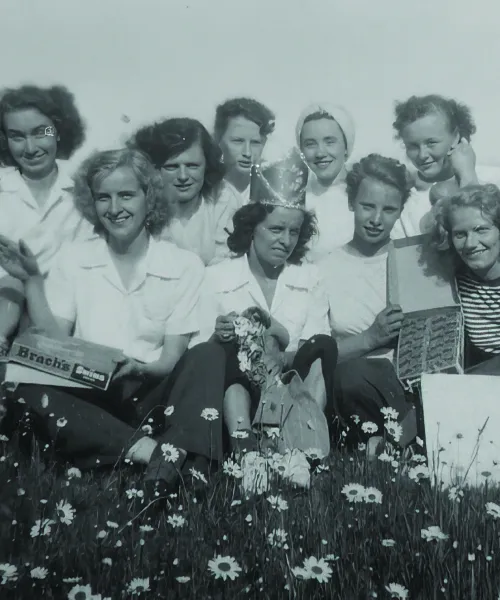
In 1928, the H. W. Gossard Company was operating ten factories, and Ishpeming’s factory, which then employed 470 workers, was rated the best factory in the United States. That year the factory was “the second largest industry in Ishpeming,” according to the local paper. The factory was poised to grow its work force even more, reported the Iron Ore on June 9, 1928. “The Gossard company recently closed its factory at Janesville, Wisconsin, and most of the machinery that was in use there has been shipped here and installed.” These changes, said the article, augured a bright future for the Ishpeming factory.
Each day hundreds of female workers from rural towns made their way to 308 Cleveland Avenue in Ishpeming, the Gossard factory. Some drove, some carpooled, and some rode a bus. But most just walked whether it was one block, twelve blocks, or several miles. In the fall, morning temperatures would start hovering in the 30s and continue to fall throughout the winter months. As female workers, many in work dresses and bundled under wool coats and scarves, clogged Ishpeming's sidewalks and streets, the Gossard clock chimed four times an hour, informing walkers to increase or slow down their pace.
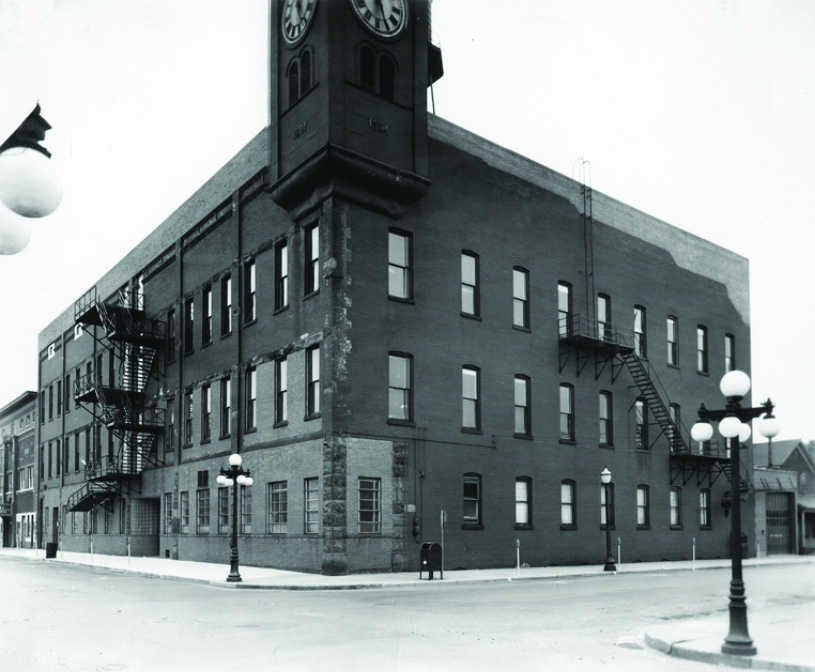
The workday began at 7:00 a.m., but some machine operators would arrive early to "beat the clock.” Harold Johnson, a mechanic, "opened the plant in the morning no earlier than a few minutes before seven a.m.,” according to his son Peter.
Gossard Girl Elaine Peterson also knew "there would be girls lined up alongside the building anxious to be let in to work when the power to the machines would have been turned off.” In the absence of power, these workers "turned their machines' wheels manually,” said Elaine.
When the doors were unlocked, the factory's interior came alive as hundreds of women, talking and laughing, poured through one of three Gossard entrances and headed to the first-floor numbered coat racks packed with four hundred to five hundred hangers. Workers, some in galoshes (rubber boots that zipped in the front), some in leather heels, and some in sturdy flats, filed up wood stairs with a daily staccato rhythm of clicking heels.
Office workers, most of whom were women, began their daily routines on the first floor while machine operators headed to their workstations on the second and third floors. Lighting in the 14 ft., 2 in. high ceilings provided critical illumination in the large airy rooms. Large wood-frame windows helped ventilate a workspace where heat was generated from hundreds of workers and hundreds of whirring sewing machines. A metal tube called a shaft powered clusters of ten to twelve industrial machines mounted on endlessly long rows of rectangular wood tables.
“They just had rows and rows of machines,” said Gossard Girl Remigia Davey. “Rows of machines on one side and more machines on the other side.”
Added Gossard Girl Marjorie Ketola, "Everybody was facing each other. We each had a little wooden box. You would get your own thread and needles. Everyone brought their own pad to sit on as the chairs were not comfortable.” Furthermore, said machine operator Phyllis Miller, "We sat in the same seat, and we had to get permission from our boss to use the bathroom. There were so many big, long shafts. They examined our work very carefully.” Like Cecilia Kangas, many Gossard Girls would also remember the deafening level of noise from hundreds of sewing machines.
Before power to the machines was turned on by a mechanic, machine operators pumped oil from a common metal drum on the second and third floors into their Singer oil cans, oiled their machines, and inventoried supplies or "findings" (i.e., bobbins, thread, zippers) in their personal wooden work boxes. Meanwhile, department heads (also called supervisors) distributed bundles to operators under their direction.
Replenished and refreshed from a lunch break and stretching one's legs, pieceworkers returned, and the rhythms of the assembly line resumed. The mechanic turned on power to industrial machines; pieceworkers inventoried findings in their work boxes; department heads passed out bundles; machine operators resumed work; a highly skilled machine operator sewed a sale sample bra for Gossard traveling salespeople; inspectors, armed with special tools, scrutinized finished undergarments; repair cutters matched flawed materials; repair workers fixed damaged undergarments and returned them to their bundles via the hand elevator (bucket on a rope); floor ladies checked machine operators' work and notified operators about problems identified by department heads; the ironer prepared finished garments for shipping.
Some pieceworkers kept a notebook of their completed work (model type and number, completed units, and amount earned). They affixed their coupons—receipts for completed work—on a sticky, a card used daily to document workers' arrival and departure times. Three chimes from the Gossard clock signaled the end of a pieceworkers' day, though some worked longer to finish a bundle, to speak with a department head, or to meet with an office worker. Regardless, all pieceworkers punched out on their floor's time clock. As they left, they inserted their stickies through a designated slot in locked wooden boxes on the second and third floors. The staccato of heels and lively female chatter followed as hundreds of Gossard Girls, shoulder to shoulder, trundled down the worn wood stairs. Some workers stopped at the office while most grabbed their coats and joined Ishpeming's rush-hour foot and car traffic.
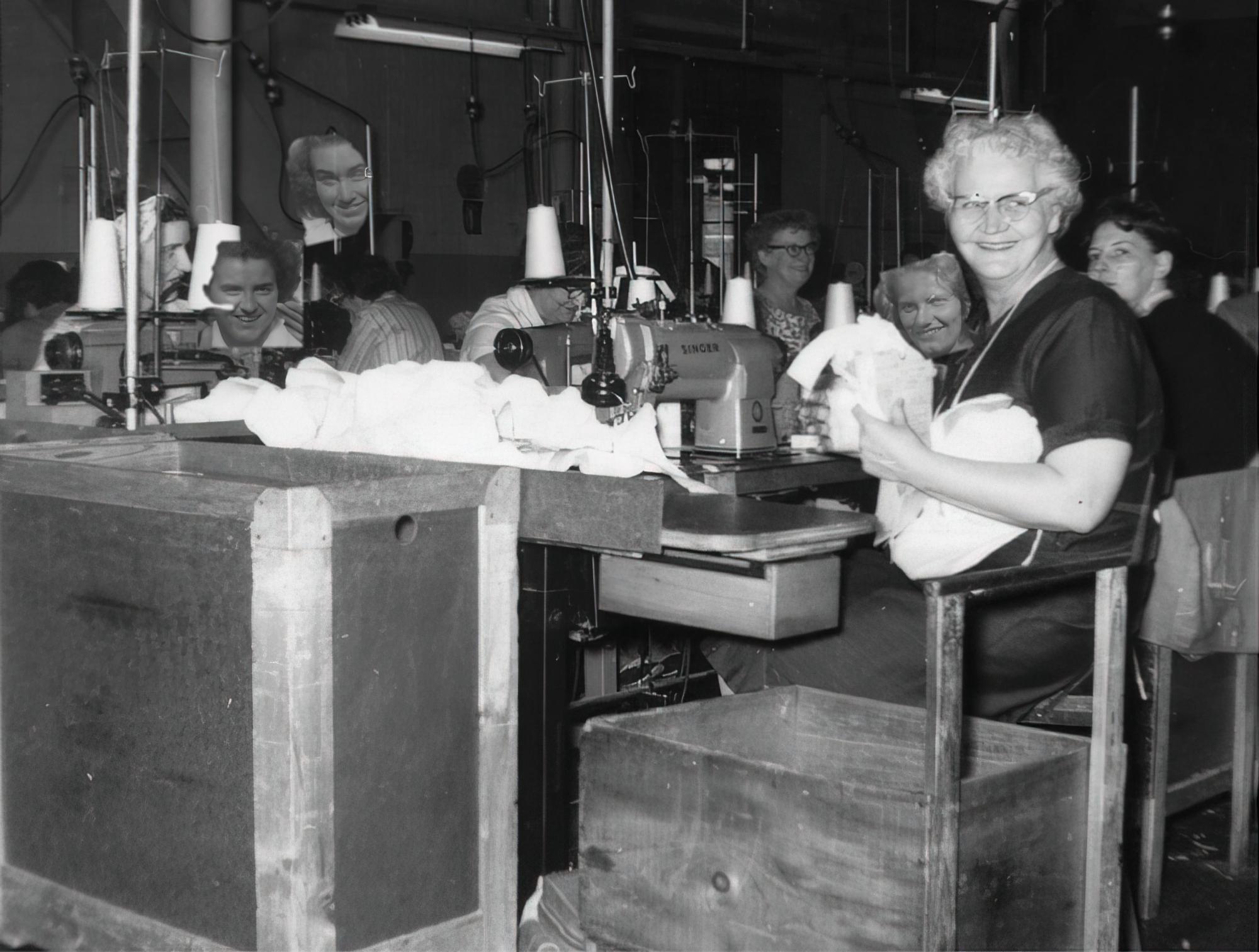
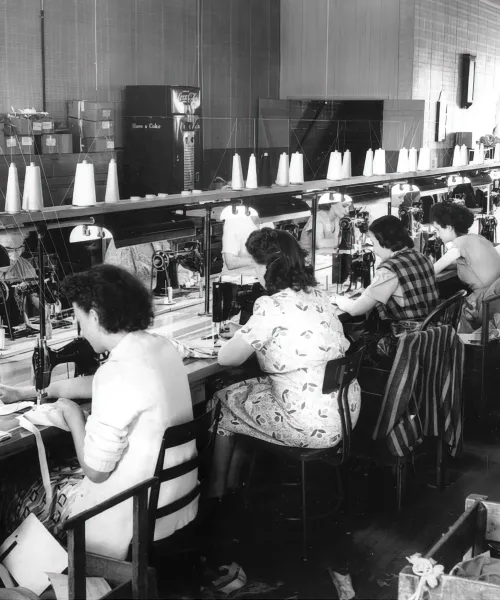
Pieceworkers operate industrial machines on the second or third floor of Ishpeming's plant. Undated photo. Digital file provided by Superior View/Jack Deo.
Fast forward to 1949…
Before the sun rose on Tuesday, April 12, 1949, the H. W. Gossard factory was bustling with activity. Marquette’s Mining Journal (MJ) reported a crowd "of 200 women, some carrying signs,” had been at the Gossard plant since 5:15 a.m. Under the watchful eyes of head union organizers, Geraldine Gordon and Gossard Girl Ruth Craine, picketers positioned themselves around the factory to prevent "anyone from entering the plant.” Picketers maintained a peaceful presence despite attempts by nonunion Gossard employees to enter the building. Gordon said that nonunion workers entered the factory. They took "some of the cut work to other plants, either to Gwinn to be completed, or to subcontract it to other corset manufacturers in the Middle West who would then finish the product so... the company could continue to fill its orders, or at the minimum complete the orders that were already in process.” Meanwhile Ishpeming's city police and Marquette County's sheriff's department stood by "to see that order was maintained,” reported the MJ. The orderly first day soon shifted to a week of rising tensions between nonunion workers and picketers….
Tensions spilled over the following morning, and Marquette's newspaper reported on an accident outside Gwinn's factory. Up to nine Gossard picketers had been injured by a car.... three women sustained serious injuries while six received minor injuries.
On August 2, the sixteen-week strike ended. "The company submitted an offer which has been accepted and ratified by the union members" at a meeting in Ishpeming's American Legion, Geraldine reported…. Employees returned to work Friday, August 5, 1949, with mixed emotions. Prounion, antiunion, and the undecided were working side by side, a testament to their ability to move past personal differences.
"We took charge in a small town.” Not an easy task for women in the late 1940s. Cultural expectations for women like Elaine Peterson did not include working outside of the home let alone going on strike. Decades later, this is what the retired Gossard Girl hoped future generations would learn from the history of the H. W. Gossard in her hometown, Ishpeming, Michigan. Elaine was one of many Gossard Girls who made history in the Upper Peninsula, when they took charge in the bustling town of ten thousand.
"The struggle to become a union shop wasn't easy,” Elaine said. The H. W Gossard Company had agreed to a wage scale settlement, vacation, work hours, and seniority. However, the company would not agree to a union shop. While the four-month strike would strain the social, political, and economic fabric of the bustling town, the strike also empowered some Gossard Girls in ways they never imagined. For Elaine, the struggle taught her to "make your point and stick to it. Never give in.”
In closing, Wong added, “What the women did was a precursor to the Women’s Movement of the 1960s to today. The Gossard Girls showed how their independence, friendships and hard work earned them respect, honor and money. Their story should inspire every reader.”
This work originally appeared in Phyllis Michael Wong’s We Kept Our Towns Going, 2022, published by Michigan State University Press.
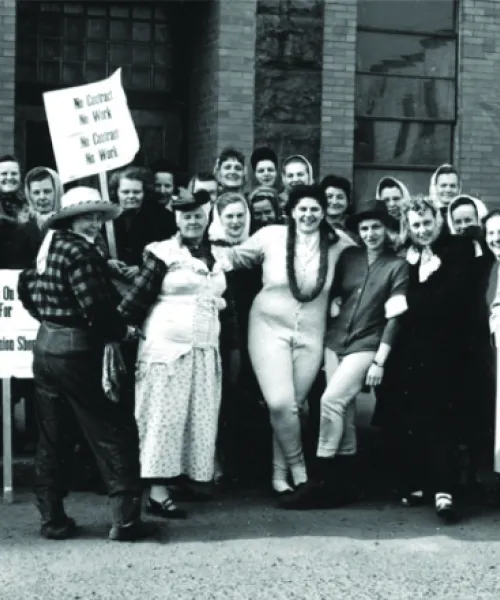
Gossard strikers in front of Ishpeming's factory, 1949. Digital file provided by Superior View/Jack Deo.
